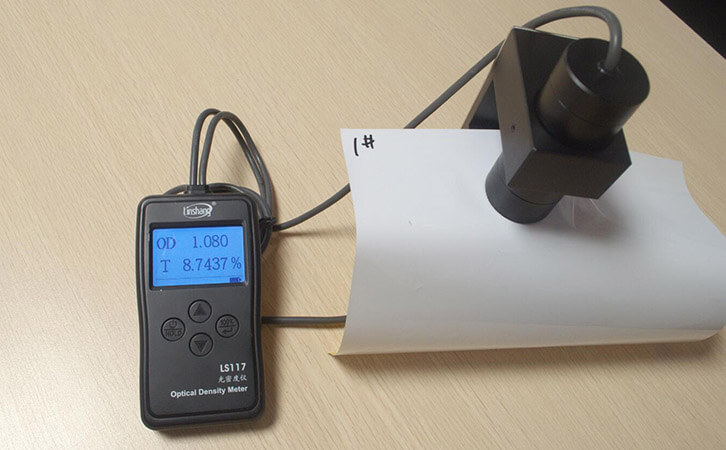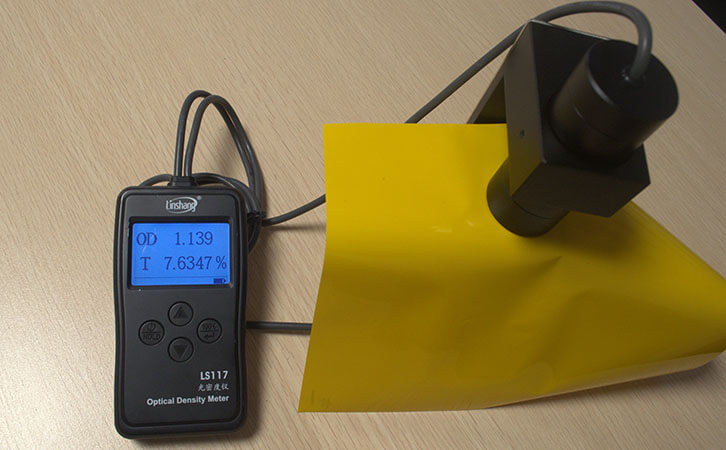Polyimide Film Performance and Transmittance Measurement
Polyimide film, also called polyimide film, is a kind of thin-film insulating material. It is mainly made of pyromellitic dianhydride (PMDA) and diaminodiphenyl ether (DDE) in a strong polar solvent through polycondensation and casting to form a film and then imidization.
Polyimide film generally appears yellow, but now it can be made into various colors.
1. Polyimide film functions
Polyimide film has good functions, such as high temperature resistance, electrical insulation, adhesion, corrosion resistance, medium resistance and many other functions, so it is widely used. It can be used in space technology, motor insulation, aerospace, aviation, mobile phones, computers, smelting, and other industries.
The general Polyimide film will appear yellow. The measured optical density value measured with a densitometer is 1.39-1.45. Since the Polyimide film is widely used in various industries, different industries will have different requirements for the optical density values as well as the light transmittance.
2. Factors affect Polyimide film performance
The visible light transmittance and optical density value of the Polyimide film used on the mobile phone display screen will be directly affected by the heat resistance. The light transmittance and optical density will also directly affect the effect of the display screen. Compared with the general aromatic Polyimide film PI-A, the heat resistance and mechanical functions of the fluorine-containing film are slightly lower. But the light transmittance at 450 nm is increased by 65% and the solubility and dielectric functions are also greatly improved. The thermal function and dielectric function of the film PI-C prepared by the chemical effect dehydration cyclization are slightly lower than that of the film PI-T prepared by the thermal effect. However, it has better light transmittance, solubility and mechanical functions.
3. How to measure visible light transmittance of Polyimide films?
Measuring the light transmittance and optical density values of Polyimide films is necessary. It is recommended to use Linshang LS117 densitometer for the measurement of Polyimide film light transmittance. LS117 densitometer use diffuse transmission principle, which is very suitable for measuring frosted materials, opalescent and translucent materials. The instrument conforms to the CIE photopic function standard.
One customer sent us some Polyimide films and hope us to test the optical performance of the materials for him. The specific measurement results are as follows:
| LS117 light transmittance test result | ||
| White | Yellow | |
| 1# | OD:1.080 T:8.7437% | OD:1.139 T:7.6347% |
| 2# | OD:1.019 T:10.053% | OD:1.061 T:9.1219% |
| 3# | OD:1.193 T:6.7524% | OD:1.266 T:5.7184% |


The LS117 densitometer measuring principle: select the logarithm of the ratio of incident light to transmitted light, or the logarithm of the reciprocal of the transmittance. The calculation formula is OD=log10 (incident light/transmitted light) or OD=log10 (1/transmittance). Generally, when testing materials with very low light transmittance, it is difficult to compare the difference with the light transmittance. It will be more intuitive to convert the data into the optical density value. The optical density value can be measured to OD 6 and the transmittance resolution can reach up to 0.0005%.
- LS117 Optical Densitometer Measure Welding Mask Glass
- Companre LS117 Optical Density Meter With Others
- LS117 Densitometer Measure Application
- Difference of LS117 Densitometer and X-Rite 341 Densitometer
- LS117 Transmission Densitometer-Related Knowledge
- The details of LS152 glass light transmittance on-line monitoring device